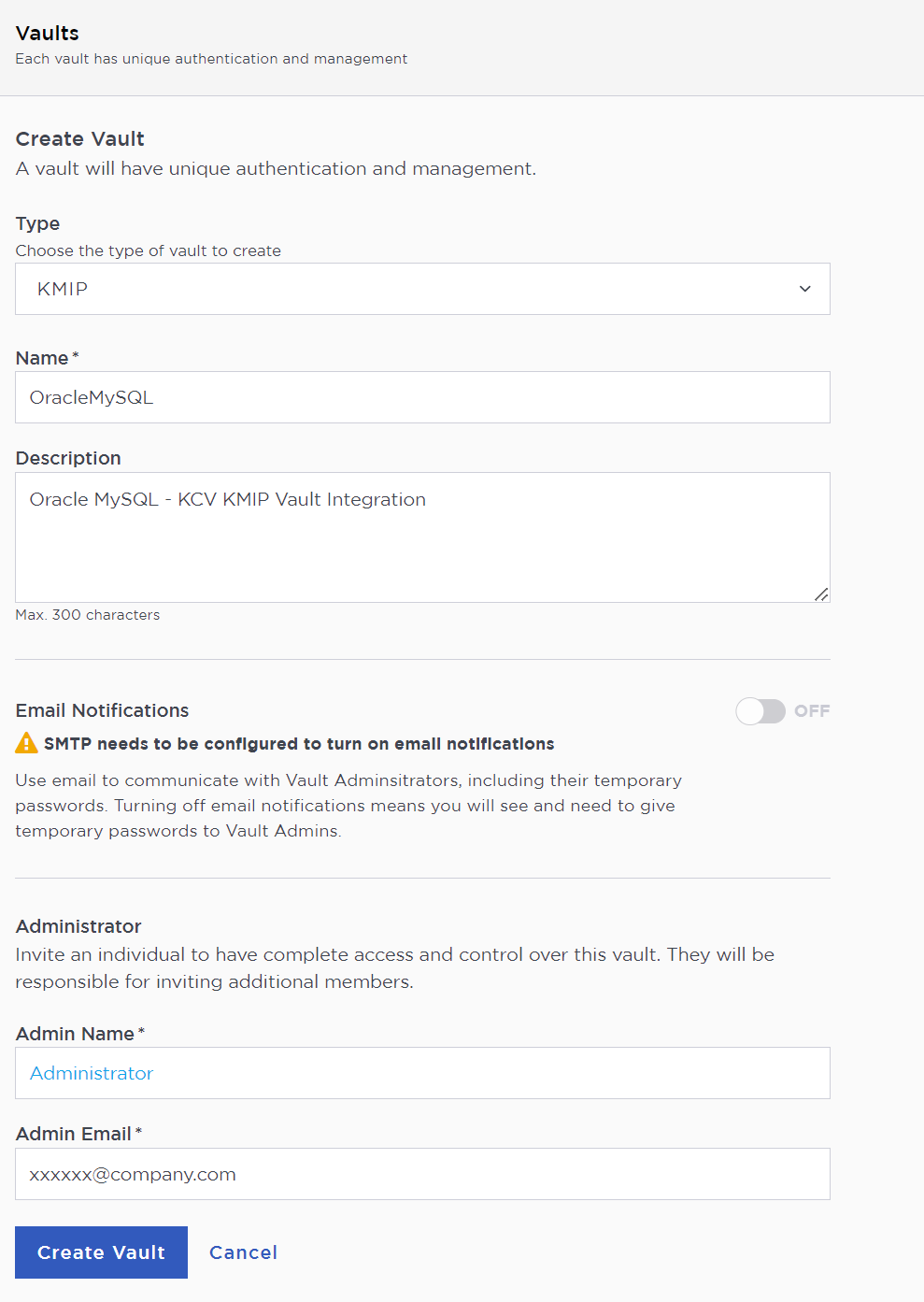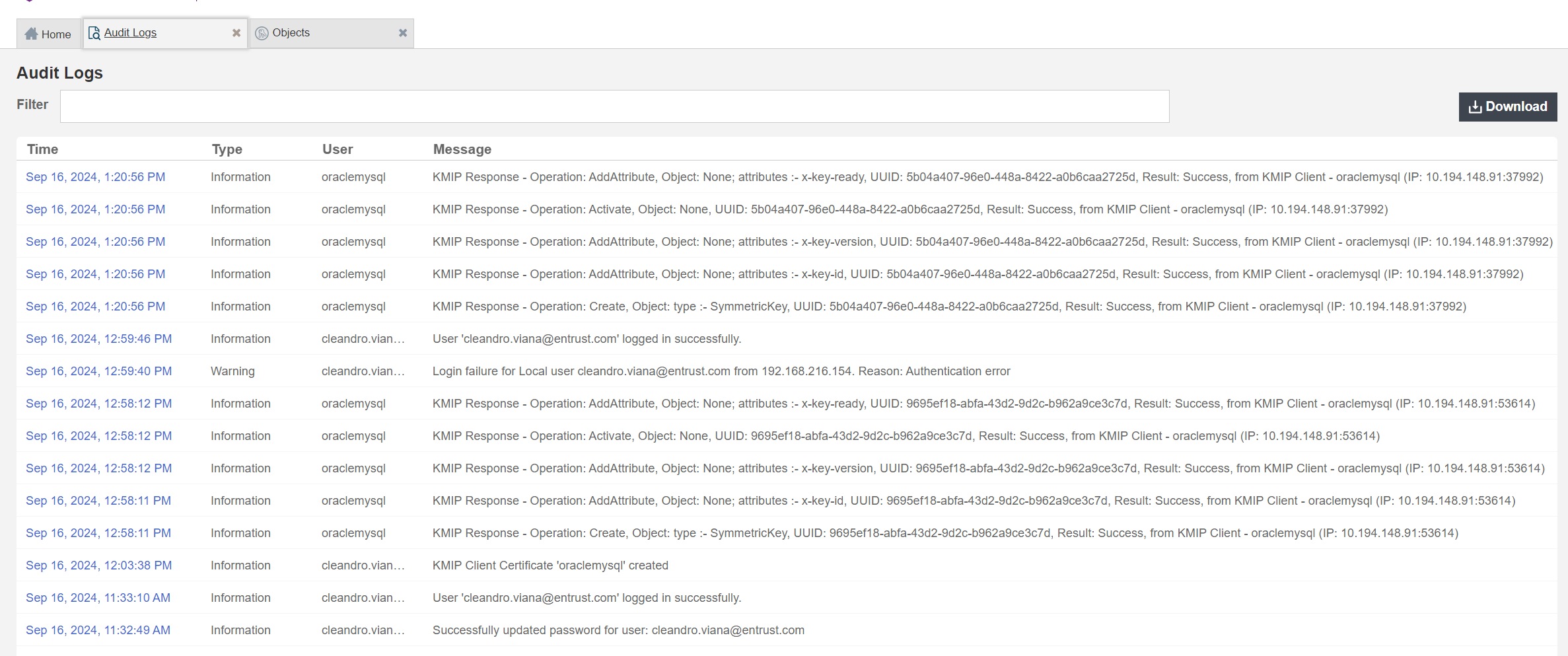Procedures
Install and configure KeyControl
Follow the installation and setup instructions in the Entrust KeyControl Vault nShield HSM Integration Guide. You can access it from the Entrust Document Library and from the nShield Product Documentation website.
Creating a KMIP Vault in the KeyControl Vault Management interface
-
Sign in to the KeyControl Vault Server web UI.
Use your browser to access the IP address of the server and sign in with the secroot credentials.
-
If you are not in the Vault Management interface, select SWITCH TO: Manage Vaults in the Menu Header.
-
In the KeyControl Vault Management interface, select Create Vault.

-
In the Create Vault page, create a KMIP Vault.

A temporary password will be emailed to the administrator’s email address. This is the password that will be used to sign in for the first time to the KMIP Vaults space in KeyControl. In a closed-gap environment where email is not available, the password for the user is displayed when you first create the vault. That can be copied and sent to the user.
-
Select Create Vault.
-
Select Close when the vault creation completes.
The newly vault appears on the vault dashboard and the KMIP server settings on the appliance are enabled.
KMIP server settings
The KMIP server settings are set at the KeyControl appliance level and apply to all the KMIP vaults in the appliance.
To use external key management and configure the KeyControl Vault KMIP settings, refer to the KMIP Client and Server Configuration section of the admin guide.
When you are using external key management, as is the case in this solution, the KeyControl server is the KMIP server and the Oracle MySQL server is the KMIP client.
-
Select the Settings icon on the top right to view/change the KMIP settings.
The defaults settings are appropriate for most applications. Make any changes necessary.

-
Select Apply.
Establish trust between the KeyControl Vault Server and Oracle MySQL with KeyControl Certificates
Certificates are required to facilitate the KMIP communications from the KeyControl KMIP vault and the Oracle MySQL application and conversely. The built-in capabilities in the KMIP Vault are used to create and publish the certificates. To be able to establish trust between the KeyControl and Oracle MySQL, you must create certificates in KeyControl and upload or import them into the configuration of Oracle MySQL.
For more information on how to create a certificate bundle, see Establishing a Trusted Connection with a KeyControl Vault-Generated CSR.
| Entrust tested using certificates without password protection. The MySQL online documentation describes the steps needed to use a password-protected keyring_okv key, see Password-Protecting the keyring_okv Key File. |
-
Sign in to the KMIP vault that created earlier. Use the URL and credentials provided to the administrator of the vault.
-
Select Security, then Client Certificates.

-
In the Manage Client Certificate page, select the + icon on the right to create a new certificate.
-
In the Create Client Certificate dialog box:
-
Enter a name in the Certificate Name field. (oraclemysql)
-
Set the date on which you want the certificate to expire in the Certificate Expiration field.
-
Select Create.
The new certificates are added to the Manage Client Certificate pane.
-
-
Select the certificate and select the Download icon to download the certificate.
The web UI downloads
certname_datetimestamp.zip, which contains a user certification/key file calledcertname.pemand a server certification file calledcacert.pem. -
The download zip file contains the following:
-
A
certname.pemfile that includes both the client certificate and private key. In this example, this file is calledoraclemysql.pem.The client certificate section of the
certname.pemfile includes the lines “-----BEGIN CERTIFICATE-----" and “-----END CERTIFICATE-----" and all text between them.The private key section of the
certname.pemfile includes the lines “-----BEGIN PRIVATE KEY-----" and “-----END PRIVATE KEY-----" and all text in between them. -
A
cacert.pemfile which is the root certificate for the KMS cluster. It is always namedcacert.pem.
You will use these files in the Oracle MySQL KMIP configuration.
-
-
Transfer the zip file to the Oracle MySQL server.
% scp oraclemysql_2024-09-16-16-04-47.zip <youruseid>@<oraclemysql-server-ip-address>:/home/<youruserid>/. -
Sign in to the Oracle MySQL server and unzip the file.
% unzip oraclemysql_2024-09-16-16-04-47.zipArchive: oraclemysql_2024-09-16-16-04-47.zip inflating: oraclemysql.pem inflating: cacert.pemThese files will be used in the configuration. First, Install the Oracle MySQL server.
Install the Oracle MySQL server
The process for installing the Oracle MySQL Enterprise Edition depends on the operating system on which you are installing it. See the Oracle online documentation for details on how to install Oracle MySQL Enterprise Edition in your environment.
Install the keyring_okv plugin
The keyring_okv plugin is a KMIP 1.1 plugin for KMIP-compatible back-end keyring storage products, such as KeyControl Vault.
It is available in MySQL Enterprise Edition distributions.
The configuration directory used by keyring_okv as the location for its support files should have a restrictive mode and be accessible only to the account used to run the MySQL server.
For example, on Unix and Unix-like systems, to use the /usr/local/mysql/mysql-keyring-okv directory, the following commands, executed as root, create the directory and set its mode and ownership:
cd /usr/local
sudo mkdir -p mysql/mysql-keyring-okv/ssl
sudo chmod -R 750 mysql
sudo chown -R mysql mysql
sudo chgrp -R mysql mysqlTo be usable during the server startup process, the keyring_okv plugin must be loaded using the --early-plugin-load option.
Also, set the keyring_okv_conf_dir system variable to tell keyring_okv where to find its configuration directory.
Edit the /etc/my.cnf file and add the plugin into the mysqld section:
[mysqld]
early-plugin-load=keyring_okv.so
keyring_okv_conf_dir=/usr/local/mysql/mysql-keyring-okvImport the KeyControl KMIP Certificates to the keyring_okv plugin
The certificates must be installed before running the keyring_okv plugin, so that the plugin can be initialized.
-
Import the certificates into the configuration directory for the
keyring_okvplugin.The following files need to be imported:
-
A
<cert_name>.pemfile that includes both the client certificate and private key. The administrator needs to open this single file and paste the two sections of the file into thecert.pemandkey.pemfiles in the/usr/local/mysql/mysql-keyring-okv/ssldirectory.-
The client certificate section of the
<cert_name>.pemfile includes the lines"-----BEGIN CERTIFICATE-----"and"-----END CERTIFICATE-----"and all text between them.Open or create
/usr/local/mysql/mysql-keyring-okv/ssl/cert.pemand paste"-----BEGIN CERTIFICATE-----"and"-----END CERTIFICATE-----"and all text between them into this file. Make sure it has a carriage return at the end of the file. -
The private key section of the
<cert_name>.pemfile includes the lines"-----BEGIN PRIVATE KEY-----"and"-----END PRIVATE KEY-----"and all text in between them.Open or create
/usr/local/mysql/mysql-keyring-okv/ssl/key.pemand paste"-----BEGIN CERTIFICATE-----"and"-----END CERTIFICATE-----"and all text between them into this file. Make sure it has a carriage return at the end of the file.
-
-
A
cacert.pemfile, which is the root certificate for the KMS cluster. It is always namedcacert.pem.This file needs to be copied to
/usr/local/mysql/mysql-keyring-okv/ssl/CA.pem.
-
-
In the configuration directory, create a
okvclient.orafile with the following format:SERVER=xxx.xxx.xxx.xxx:5696 STANDBY_SERVER=xxx.xxx.xxx.xxx:5696STANDBY_SERVERis optional.For example:
SERVER=198.51.100.20:5696 STANDBY_SERVER=198.51.100.21:5696These are the IP addresses of the KeyControl Vault servers.
-
Set the permissions on these files:
cd /usr/local/mysql/mysql-keyring-okv sudo chmod -R 750 mysql . sudo chown -R mysql . sudo chgrp -R mysql . -
If the firewall is running open up the firewall for port 5696.
As the root user on the mysql server:
% firewall-cmd --zone=public --add-port=5696/tcp --permanent % firewall-cmd --zone=public --add-port=5696/udp --permanent % firewall-cmd --reload -
Disable SELinux the next time the server reboots.
To do this, in the
/etc/selinux/configfile setSELINUX=disabled.To disable on the current shell:
% sudo setenforce 0We are disabling SELinux for the purpose of the integration. Consult with your security team on how to handle SELinux in this case. -
After completing the preceding procedure, restart the MySQL server:
% sudo systemctl restart mysqld % sudo systemctl status mysqldIt loads the
keyring_okvplugin, which uses the files in its configuration directory to communicate with KeyControl.
Verify that the keyring_okv plugin is working
After configuration is complete and you restarted MySQL to load the keyring_okv plugin, look in the /varlog/mysqld.log logs to make sure there are no errors when connecting to KeyControl.
For example, the mysqld.log file could report the following errors if the plugin does not work:
2024-09-16T18:53:39.117806Z 0 [System] [MY-010116] [Server] /usr/sbin/mysqld (mysqld 8.4.2-commercial) starting as process 8034
2024-09-16T18:53:39.123096Z 0 [ERROR] [MY-011398] [Server] Plugin keyring_okv reported: 'Error loading trust store'
2024-09-16T18:53:39.123152Z 0 [ERROR] [MY-011386] [Server] Plugin keyring_okv reported: 'Could not initialize ssl layer'
2024-09-16T18:53:39.123163Z 0 [ERROR] [MY-011377] [Server] Plugin keyring_okv reported: 'keyring_okv initialization failure. Please check that the keyring_okv_conf_dir points to a readable directory and that the directory contains Oracle Key Vault configuration file and ssl materials. Please also check that Oracle Key Vault is up and running.'
2024-09-16T18:53:39.123170Z 0 [ERROR] [MY-010202] [Server] Plugin 'keyring_okv' init function returned error.In this case, make sure the file permissions are correct in the keyring configuration directory and that the certificate files are named correctly.
To verify the plugin installation, with the MySQL server running, examine the INFORMATION_SCHEMA.PLUGINS table or use the SHOW PLUGINS statement.
For example:
mysql> SELECT PLUGIN_NAME, PLUGIN_STATUS FROM INFORMATION_SCHEMA.PLUGINS WHERE PLUGIN_NAME LIKE 'keyring%';
+-------------+---------------+
| PLUGIN_NAME | PLUGIN_STATUS |
+-------------+---------------+
| keyring_okv | ACTIVE |
+-------------+---------------+
1 row in set (0.00 sec)Use keyring_okv plugin to create encrypted tables
When you create the first encrypted table, InnoDB will ask keyring_okv to generate the primary key (AES-256) in KeyControl.
This primary key is used to encrypt tablespace keys.
You can check the primary key in the KeyControl KMIP Vault web interface by selecting Objects in the Home tab.
InnoDB also asks KeyControl to generate a key (AES-256) for the encrypting table. The tablespace key is wrapped using the primary key and stored alongside the encrypted table. For subsequent encrypted tables, only the tablespace key is generated and the same primary key is used to wrap the tablespace key.
With KeyControl, you will see a complete audit trail if every time the primary key or tablespace key is retrieved. You will have complete control on these keys. You can revoke access to a key or disable it, to lock down your data at rest.
To create an encrypted table:
-
Sign in to the MySQL database:
% mysql -u root -p<password> -
Create the encrypted table with the following SQL:
CREATE DATABASE MySQL_TDE_Test; USE MySQL_TDE_Test; CREATE TABLE `test_encryption` ( `id` int(10) unsigned NOT NULL AUTO_INCREMENT, `name` varchar(15) NOT NULL, PRIMARY KEY (`id`) ) ENGINE=InnoDB AUTO_INCREMENT=1 DEFAULT CHARSET=latin1 ENCRYPTION = 'Y';The Objects tab in the KeyControl KMIP Vault web UI shows the that the key was created. For example:

You can also check the Audit Logs tab. You should see all the KMIP operations that happened during that key creation process and retrieval. For example:

Test that encryption KeyControl is working
-
Log in into the MySQL database:
% mysql -u root -p<password> -
Insert a record to the table that was created earlier:
mysql> USE MySQL_TDE_Test; Database changed mysql> INSERT INTO test_encryption VALUES (1, 'clive'); Query OK, 1 row affected (0.00 sec) mysql> select * from test_encryption; +----+----------+ | id | name | +----+----------+ | 1 | clive | +----+----------+ 1 row in set (0.00 sec) -
Edit the MySQL configuration file and disable the
keyring_okvplugin:% sudo vi /etc/my.cnf #early-plugin-load=keyring_okv.so #keyring_okv_conf_dir=/usr/local/mysql/mysql-keyring-okv -
Restart MySQL:
% sudo systemctl restart mysqld -
Check that you can read the encrypted table:
% mysql -u root -p<password> mysql> use MySQL_TDE_Test; Database changed mysql> select * from test_encryption; ERROR 3185 (HY000): Cannot find master key from keyring, please check in the server log if a keyring is loaded and initialized successfully.The table is not accessible because MySQL cannot get to the master key from the keyring.
-
Re-enable the keyring in the MySQL configuration file and remove the comments you added previously:
% sudo vi /etc/my.cnf early-plugin-load=keyring_okv.so keyring_okv_conf_dir=/usr/local/mysql/mysql-keyring-okv -
Restart MySQL:
% sudo systemctl restart mysqld -
Check that you can view the encrypted table:
% mysql -u root -p<password> mysql> use MySQL_TDE_Test; Database changed mysql> select * from test_encryption; +----+----------+ | id | name | +----+----------+ | 1 | clive | +----+----------+ 1 row in set (0.00 sec)
This shows that the configuration of the keyring_okv plugin using KeyControl is working.
Key rotation
Rotating the master key is the same thing as generating a new key to replace the old one. In MySQL, when you use InnoDB encrypted tables, there is a MASTER KEY. You can rotate this using the following command:
ALTER INSTANCE ROTATE INNODB MASTER KEY;The new key is generated and the old one is replaced.
Let’s give it a try and see what happens:
-
Sign in to MySQL and run the
ALTER INSTANCE ROTATEcommand.% mysql -u root -p<password> mysql> ALTER INSTANCE ROTATE INNODB MASTER KEY; Query OK, 0 rows affected (0.22 sec) -
Check in the KeyControl KMIP Vault web UI under the Objects tab for the new key.

You will also be able to see the activity for the new key creation on the audit logs in the Audit Logs Tab.

-
Revoke the old key.
In the KeyControl KMIP Vault web UI under the Objects tab, select the old key and select Actions. In the dropdown menu select Revoke to revoke the key.

We are just doing this to assure that MySQL cannot use the old key. In reality MySQL will just use the new key that has been created. The old key can stay active if you wish to do so. -
Restart MySQL:
% sudo systemctl restart mysqld -
Check if you can read the encrypted table:
% mysql -u root -p<password> mysql> use MySQL_TDE_Test; Database changed mysql> select * from test_encryption; +----+----------+ | id | name | +----+----------+ | 1 | clive | +----+----------+ 1 row in set (0.00 sec) -
To show that MySQL is using the new key that has been generated, issue the following command:
mysql> SELECT * FROM performance_schema.keyring_keys; +--------------------------------------------------+-----------+--------------------------------------+ | KEY_ID | KEY_OWNER | BACKEND_KEY_ID | +--------------------------------------------------+-----------+--------------------------------------+ | INNODBKey-xxxxxxxx-743c-11ef-8429-0050568b99be-2 | | 5b04a407-96e0-xxxx-yyyy-a0b6caa2725d | +--------------------------------------------------+-----------+--------------------------------------+ 1 row in set (0.00 sec)
As you can see, the `BACKEND_KEY_ID*`is the same as the new key that was created in the KMIP vault. This shows that the key rotation was successful.
Secure the MySQL database
The information below was taken from the following Security Technical Implementation Guides (STIG) page and can be used as guideline to address confidentiality and integrity of all information at rest in a MySQL database.
- Group Title
-
SRG-APP-000231-DB-000154
- Rule Title
-
The MySQL Database Server 8.0 must protect the confidentiality and integrity of all information at rest.
- Discussion
-
This control is intended to address the confidentiality and integrity of information at rest in non-mobile devices and covers user information and system information. Information at rest refers to the state of information when it is located on a secondary storage device, such as a disk drive or a tape drive, within an organizational information system. Applications and application users generate information throughout the course of their application use.
For more information, see InnoDB Data-at-Rest Encryption in the MySQL online documentation.
User-generated data, as well as application-specific configuration data, must be protected. Organizations may choose to employ different mechanisms to achieve confidentiality and integrity protections, as appropriate.
If the confidentiality and integrity of application data is not protected, the data will be open to compromise and unauthorized modification.
Apply appropriate controls to protect the confidentiality and integrity of data at rest in the database.
Using SQL, determine if all data-at-rest is encrypted:
-
Check
audit_log_encryption:SELECT VARIABLE_NAME, VARIABLE_VALUE FROM performance_schema.global_variables where variable_name = 'audit_log_encryption';If
audit_log_encryptionis not set toAES, this is important. -
Check
binlog_encryption:SELECT VARIABLE_NAME, VARIABLE_VALUE FROM performance_schema.global_variables where variable_name = 'binlog_encryption';If
binlog_encryptis not set toON, this is important. -
Check
innodb_redo_log_encrypt:SELECT VARIABLE_NAME, VARIABLE_VALUE FROM performance_schema.global_variables where variable_name = 'innodb_redo_log_encrypt';If
innodb_redo_log_encryptis not set toON, this is important. -
Check
innodb_undo_log_encrypt:SELECT VARIABLE_NAME, VARIABLE_VALUE FROM performance_schema.global_variables where variable_name = 'innodb_undo_log_encrypt';If
innodb_undo_log_encryptis not set toON, this is important. -
Check
general_log:SELECT VARIABLE_NAME, VARIABLE_VALUE FROM performance_schema.global_variables WHERE VARIABLE_NAME like 'general_log';If
general_logis notOFF, this is important.
Using SQL, find the encryption status for all MySQL table and tablespaces:
-
Check tablespaces:
SELECT `INNODB_TABLESPACES`.`NAME`, `INNODB_TABLESPACES`.`ENCRYPTION` FROM `information_schema`.`INNODB_TABLESPACES`;If any tablespace does not have
ENCRYPTIONset toY (yes), this is important. -
Check
innodb_redo_log_encrypt:SELECT VARIABLE_NAME, VARIABLE_VALUE FROM performance_schema.global_variables where variable_name = 'table_encryption_privilege_check';If
innodb_redo_log_encryptis not set toON, this is important.
Apply appropriate MySQL Database 8.0 controls to protect the confidentiality and integrity of data at rest in the database:
sudo vi /etc/my.cnf
[mysqld]
audit-log=FORCE_PLUS_PERMANENT
audit-log-format=JSON
audit-log-encryption=AES
#Turn on binlog encryption
set persist binlog_encryption=ON;
#Turn on undo and redo log encryption
set persist innodb_redo_log_encrypt=ON;
set persist innodb_undo_log_encrypt=ON;Enable encryption for a new file-per-table tablespace, ENCRYPTION option in a CREATE TABLE statement.
The following example assumes that innodb_file_per_table is enabled:
mysql> CREATE TABLE t1 (c1 INT) ENCRYPTION='Y';To enable encryption for an existing file-per-table tablespace, specify the ENCRYPTION option in an ALTER TABLE statement:
mysql> ALTER TABLE t1 ENCRYPTION='Y';To disable encryption for file-per-table tablespace, set ENCRYPTION='N' using ALTER TABLE:
mysql> ALTER TABLE t1 ENCRYPTION='N';To disable general_log:
mysql> SET PERSIST general_log = 'OFF';